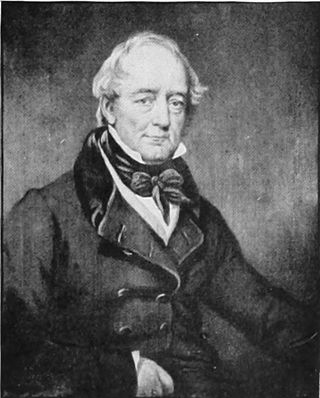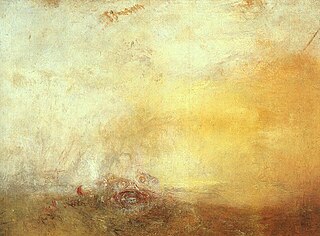
Joseph Mallord William Turner, known in his time as William Turner, was an English Romantic painter, printmaker and watercolourist. He is known for his expressive colouring, imaginative landscapes and turbulent, often violent marine paintings. He left behind more than 550 oil paintings, 2,000 watercolours, and 30,000 works on paper. He was championed by the leading English art critic John Ruskin from 1840, and is today regarded as having elevated landscape painting to an eminence rivalling history painting.

The year 1816 is known as the Year Without a Summer because of severe climate abnormalities that caused average global temperatures to decrease by 0.4–0.7 °C (0.7–1 °F). Summer temperatures in Europe were the coldest of any on record between the years of 1766 and 2000. This resulted in major food shortages across the Northern Hemisphere.

Chichester Cathedral, formally known as the Cathedral Church of the Holy Trinity, is the seat of the Anglican Bishop of Chichester. It is located in Chichester, in West Sussex, England. It was founded as a cathedral in 1075, when the seat of the bishop was moved from Selsey.
Claude Monet painted several series of nearly 100 impressionist oil paintings of different views of the Thames River in the autumn of 1899 and the early months of 1900 and 1901 during stays in London. One of these series consists of views of the Palace of Westminster, home of the British Parliament, and he began the first of these paintings at about 15.45 on 13 February 1900. All of the series' paintings share the same viewpoint from Monet's window or a terrace at St Thomas' Hospital overlooking the Thames and the approximate canvas size of 81 cm × 92 cm. They are, however, painted during different times of the day and weather conditions.

Fittleworth is a village and civil parish in the District of Chichester in West Sussex, England located seven kilometres (3 miles) west from Pulborough on the A283 road and three miles (5 km) south east from Petworth. The village has an Anglican church, a primary school and one pub, The Swan. It is within the ancient divisions of the Bury Hundred and the Rape of Arundel. The village is bounded south by the Rother Navigation.

Tate Britain, known from 1897 to 1932 as the National Gallery of British Art and from 1932 to 2000 as the Tate Gallery, is an art museum on Millbank in the City of Westminster in London, England. It is part of the Tate network of galleries in England, with Tate Modern, Tate Liverpool and Tate St Ives. It is the oldest gallery in the network, having opened in 1897. It houses a substantial collection of the art of the United Kingdom since Tudor times, and in particular has large holdings of the works of J. M. W. Turner, who bequeathed all his own collection to the nation. It is one of the largest museums in the country. The museum had 525,144 visitors in 2021, an increase of 34 percent from 2020 but still well below pre- COVID-19 pandemic levels. In 2021 it ranked 50th on the list of most-visited art museums in the world.

Charles Turner was an English mezzotint engraver and draughtsman who specialized in portraiture. He collaborated with J. M. W. Turner on the early plates of the same's Liber Studiorum.

The Burning of the Houses of Lords and Commons, 16th October, 1834 is the title of two oil on canvas paintings by J. M. W. Turner, depicting different views of the fire that broke out at the Houses of Parliament on the evening of 16 October 1834. They are now in the Philadelphia Museum of Art and Cleveland Museum of Art.

Snow Storm: Hannibal and his Army Crossing the Alps is an oil on canvas painting by J. M. W. Turner, first exhibited in 1812. Left to the nation in the Turner Bequest, it was acquired by the National Gallery in London in 1856, and is now held by the Tate Gallery.

Dido building Carthage, or The Rise of the Carthaginian Empire is an oil on canvas painting by J. M. W. Turner. The painting is one of Turner's most important works, greatly influenced by the luminous classical landscapes of Claude Lorrain. Turner described it as his chef d'oeuvre. First exhibited at the Royal Academy summer exhibition in 1815, Turner kept the painting until he left it to the nation in the Turner Bequest. It has been held by the National Gallery in London since 1856.

Sunrise with Sea Monsters is an unfinished oil painting by English artist J. M. W. Turner.

Snow Storm, or Snow Storm: Steam-Boat off a Harbour's Mouth, is a painting by English artist Joseph Mallord William Turner (1775–1851) from 1842.

Dolbadarn Castle is an oil painting by J. M. W. Turner (1775–1851) depicting Dolbadarn Castle, created in 1798–1799. It is part of a body of work completed by Turner during a tour of the region, which included Dolbadarn, Llanberis and other parts of Snowdonia. Many supporting studies can be found in a sketch book now held by Tate Britain. When Turner returned to his London studio he developed these sketches into a number of more accomplished paintings of North Wales, including this one, which is now kept at the National Library of Wales.

In 1842, British artist J. M. W. Turner painted three watercolours of the Rigi, a mountain in the Alps in Central Switzerland, which he had visited the previous summer. Widely regarded as some of his finest works, the watercolours capture the transitory effects of light and atmospheric conditions at the Rigi. According to John Ruskin, "Turner had never made any drawings [watercolours] like these before, and never made any like them again ... He is not showing his hand in these, but his heart."

Whalers is an 1845 painting by British artist J. M. W. Turner. Done in oil on canvas, the work depicts a whaling ship and her launches pursuing a whale. Originally created with the hope that collector Elhanan Bicknell would purchase it, the work is currently found in the collection of the Metropolitan Museum of Art.

Norham Castle, Sunrise is an oil-on-canvas painting by English painter J. M. W. Turner, created around 1845. The painting depicts Norham Castle, overlooking the River Tweed, the border between England and Scotland. The painting was bequeathed to the National Gallery of British Art as part of the Turner Bequest in 1856. It remains in the collection to this day. It was one of the artist's last paintings, and falls within his "Modernist" period. This piece is well known for Turner's attentiveness to dawn light, and the softened silhouette it brings.

The Golden Bough is a painting from 1834 by the English painter J. M. W. Turner. It depicts the episode of the golden bough from the Aeneid by Virgil. It is in the collection of the Tate galleries.

Tate Britain holds a self-portrait of J. M. W. Turner which it dates to c.1798 or c.1799, when the artist was aged about 23 or 24 years old.

Peace – Burial at Sea is a painting in oils on canvas by the English Romantic artist J. M. W. Turner (1775–1851), first exhibited in 1842. The work is a memorial tribute to Turner's contemporary the Scottish painter Sir David Wilkie (1786–1841). The canvas depicts Wilkie's burial at sea. This work was intended as a companion piece to War. The Exile and the Rock Limpet which alludes to the sordid demise of the former Emperor of France Napoleon Bonaparte. The two works are characterized by sharply contrasting colors and tones: War utilizes a strident yellow and red while Peace is painted a cool blend of white, blue and black.

















